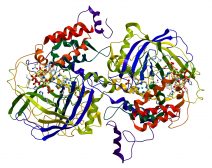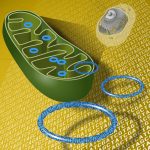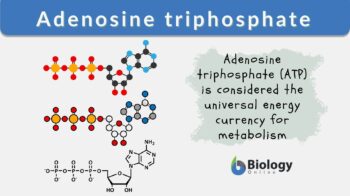
Adenosine triphosphate
n., abbreviation: ATP
Definition: a nucleoside phosphate comprised of a ribonucleoside and three phosphate groups
Table of Contents
Adenosine Triphosphate Definition
noun
plural: adenosine triphosphates
(biochemistry) An organic compound that is composed of adenosine (an adenine ring and a ribose sugar) and three phosphate groups, hence, the name; a nucleotide with a chemical formula of C10H16N5O13P3
ATP as a Nucleotide
A nucleotide is an organic compound made up of three subunits: a nucleobase, a five-carbon sugar, and a phosphate group. The sugar component may either be ribose or deoxyribose. A nucleotide is, thus, a nucleoside with a phosphate group. Depending on the number of phosphate groups attached to the sugar moiety, a nucleotide may be called nucleoside monophosphate (if with only one phosphate group), nucleoside diphosphate (with two phosphate groups), or nucleoside triphosphate (when with three phosphate groups).
Depending on the pentose sugar component, a nucleoside may be a ribonucleoside or a deoxyribonucleoside. A ribonucleoside is a nucleoside with a ribose sugar component. Based on the nucleobase component, the ribonucleoside may be adenosine, guanosine, cytidine, uridine, or 5-methyluridine. A deoxyribonucleoside is a nucleoside with a deoxyribose sugar. Similarly, depending on the nucleobase component, a deoxyribonucleoside may be deoxyadenosine, deoxyguanosine, deoxycytidine, thymidine, or deoxyuridine. Also, depending on the nucleobase component, the nucleosides may be grouped into either the “double-ringed” purine or the “single-ringed” pyrimidine.
Structure of ATP
Adenosine triphosphate (ATP) is a nucleoside phosphate comprised of a ribonucleoside and three phosphate groups. It means it has a ribose as its sugar and three phosphate groups attached. Its structure is comprised of a purine base, particularly adenine that is bound at the 9′ nitrogen atom to the 1′ carbon atom of a ribose sugar, and three phosphate groups. The removal of one or two phosphate groups yields adenosine monophosphate or adenosine diphosphate, respectively.
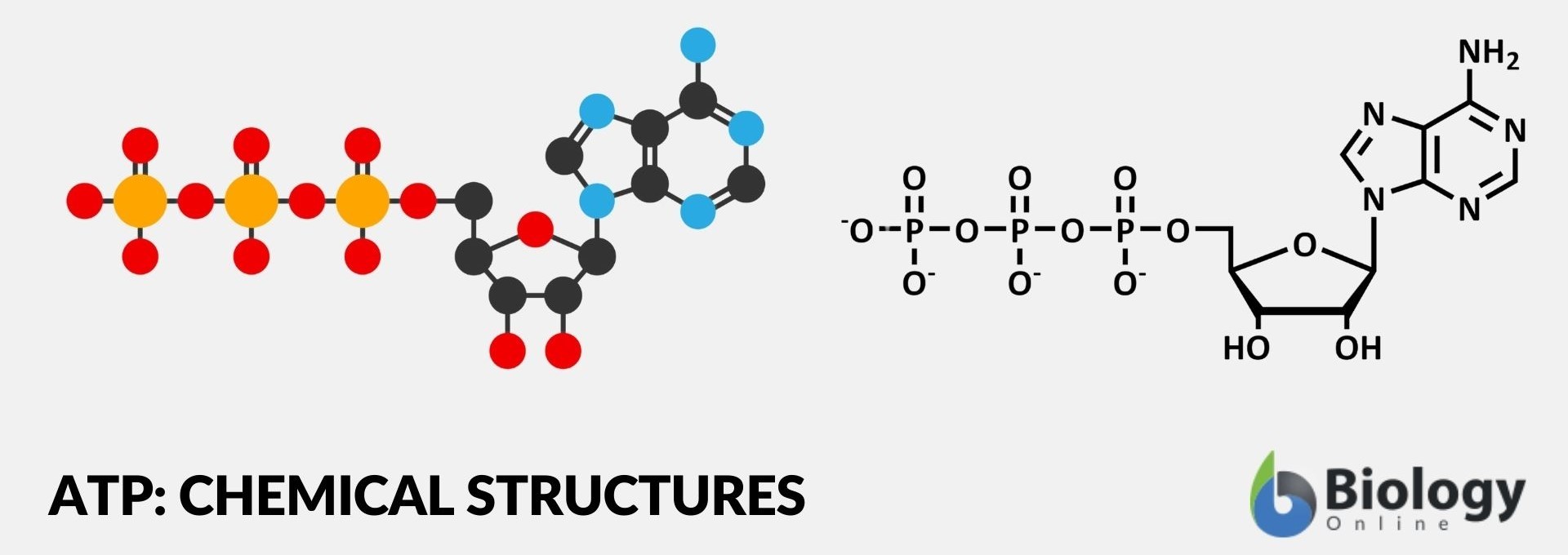
Common Biological Reactions
In eukaryotes, ATP is biosynthesized by three major pathways: (1) glycolysis, (2) Krebs cycle, and (3) beta-oxidation. The first pathway occurs in the cytoplasm whereas the next two pathways occur in the mitochondria.
Cellular respiration is a series of metabolic processes wherein the biochemical energy is harvested from an organic substance (e.g. glucose) and stored in energy-carriers like ATP. Glycolysis is the initial stage in cellular respiration that is involved in the cellular degradation of the simple sugar, glucose to pyruvate in order to yield high-energy molecules such as ATP and NADH.
The most common and well-known type of glycolysis is the Embden-Meyerhof-Parnas pathway, which was first described by Gustav Embden, Otto Meyerhof, and Jakub Karol Parnas. Other alternative pathways are exemplified by the Entner-Doudoroff pathway and the pentose phosphate pathway.
The Krebs cycle is a stage of cellular respiration following glycolysis and is characterized by its decarboxylation of pyruvate. It involves a cyclic series of enzymatic reactions through which pyruvate — converted into Acetyl Coenzyme A – is completely oxidized to CO2.
Along with this, a hydrogen ion is removed from the carbon molecules, transferring the hydrogen atoms and electrons to electron-carrier molecules (e.g. NADH and FADH2), and metabolic energy to high energy bonds (e.g. ATP). CO2 from the complete oxidation of pyruvate is removed from the cell into the blood. The electron and hydrogen carriers, NADH and FADH2, donate these electrons to the electron transport chain to generate ATP via oxidative phosphorylation, the final metabolic pathway of cellular respiration.
In eukaryotes, the Krebs Cycle occurs in the matrix of the mitochondrion whereas, in prokaryotes, it occurs in the cytoplasm.
In plants, ATP may also be produced by photosynthesis in the chloroplasts. It is also formed as one of the end products of photophosphorylation and fermentation. Fermentation is a cellular process used by certain cells and organisms (e.g. yeasts) to convert organic food into simpler compounds. In doing so, chemical energy (e.g. ATP) is generated.
Fermentation differs from cellular respiration in a way that it uses organic compounds such as carbohydrates as (endogenous) electron acceptors instead of molecular oxygen (which is an exogenous electron acceptor in cellular respiration). However, compared with oxidative phosphorylation (of cellular respiration), fermentation produces less ATP.
In mammalian muscles, they shift from oxidative phosphorylation to fermentation when oxygen supply becomes limited, especially during strenuous activity such as intensive exercising.
ATP may also be produced by combining two molecules of ADP through the action of the enzyme adenylate kinase: 2 ADP → ATP + AMP
ADP converts into ATP by the addition of a phosphate group. This occurs in processes such as substrate-level phosphorylation, oxidative phosphorylation, and photophosphorylation.
ATPs are vital in the intracellular energy transport for various metabolic processes including biosynthetic reactions, motility, and cell division. It is also used as a substrate by kinases that phosphorylate proteins and lipids, and by adenylate cyclase to produce cyclic AMP.
ATP can be degraded into AMP and pyrophosphate: ATP → AMP + PPi through hydrolysis. AMP may be further degraded by converting it ultimately into uric acid that in mammals is excreted from the body.
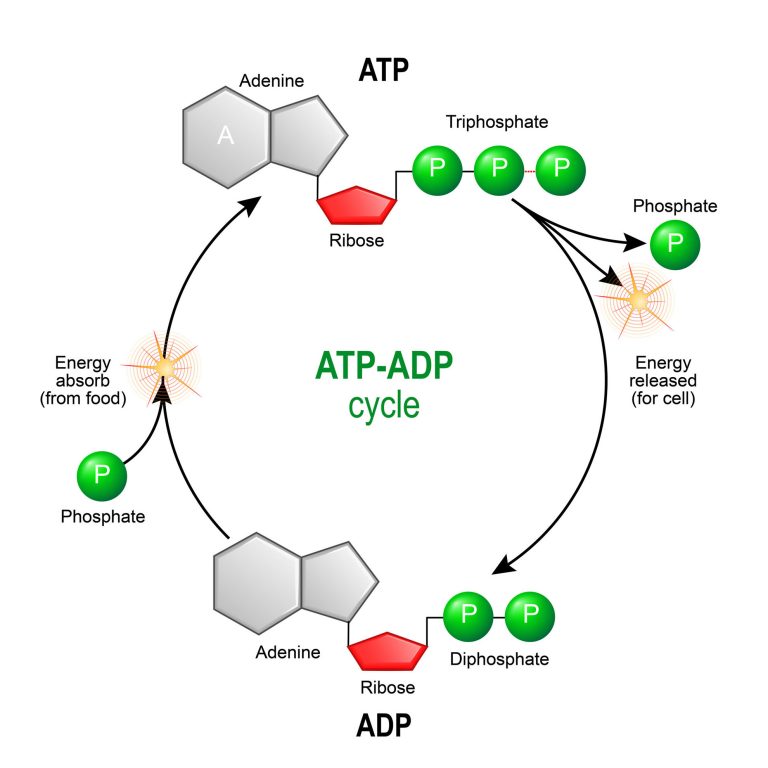
Biological Function and Importance
ATP contains a large amount of chemical energy stored in its high-energy phosphate bonds. It releases energy when it is broken down (hydrolyzed) into ADP (adenosine diphosphate). Energy is used for many metabolic processes. Hence, ATP is considered the universal energy currency for metabolism. Its functions are for intracellular energy transport for various metabolic processes including biosynthetic reactions, motility, and cell division.
ATP also serves as a source for ADP and AMP. ADP is essential in photosynthesis and glycolysis. It is the end-product when adenosine triphosphate ATP loses one of its phosphate groups. The energy released in the process is used to power up many vital cellular processes. ADP is also important during the activation of platelets. It is stored inside the platelet and is released to interact with ADP receptors (e.g. P2Y1 receptors, P2Y12 receptors, etc.) on platelets.
READ: ATP & ADP – Biological Energy
See also
- nucleotide
- DNA
- RNA
- adenosine
- deoxyadenosine triphosphate (dATP)
- adenosine monophosphate (AMP)
- adenosine diphosphate
- cellular respiration
- mitochondrion
- glycolysis
- fermentation
© Biology Online. Content provided and moderated by Biology Online Editors.




